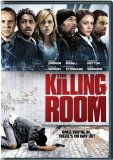“In 1975 The Rockefeller Commission was appointed to investigate covert mind-control programs conducted by the CIA in the 1950’s and 60’s. These programs were known as Project MK-ULTRA. By the time of the investigation, documents relating to MK-ULTRA programs were destroyed. With out these documents, it was impossible to verify whether the MK-ULTRA program had in fact been discontinued.”
You can guess how the film intends to answer that question, can’t you?
Volunteers are offered $250 to participate in a study. They are brought into a bright white room with white furniture and given extensive moral questionnaires to fill out. You know the kind. If you were on a sinking ship who would you first try and save? A. Yourself. B. Others. C. No one. This particular test group consists of four young people; one woman and three men. After a time, they are joined by Dr. Phillips (Stormare). He informs them they are about to enter phase one of the experiment. To tell you more would be to take away some genuine shock moments and likely ruin the experience for you. Suffice it to say that the study group is engaged in a game of survival where only one has a chance to walk out alive. The study is being monitored by a potential recruit to the project, Ms. Reilly (Sevigny). Her reactions and observations are a test to see if she can cut it in the program. Failure is not an option you can live with.
I was quite skeptical about this film when I first read the plot outline. I expected another cheap imitation of the trendy torture porn genre. That didn’t mean I thought it was necessarily bad, just predictable. This is not a part of that genre at all, as it turns out. It’s actually a very effective study in suspense. It’s bloody, but never overly so. We don’t have the traditional stalking or torture scenes here. There is torture, to be sure, but it is more psychological than anything else. I could do without the political statements toward the big reveal, but nothing played too hard handedly here. There is an element of realism that adds that one subtle touch that makes this a better film than the sum of its parts.
The acting is a step above what you often get in these kinds of chillers. Peter Stormare has always been a rather effective actor. Known mostly for his role as the mob boss Abruzzi from Prison Break, he has been a busy character actor both on television and in films. He has just the right amount of authoritarian and creepy elements to make him a most compelling character in the film. He’s the kind of actor that always demands your attention. You always get the instinctual feeling that you really don’t want to cross this guy. All at the same time he has an unlimited ability to set you at ease just when it serves the story. He was a perfect choice to play Dr. Phillips. Chloe Seigny plays the observant Ms. Reilly, and at times she is also quite good. Her character runs through a gauntlet of emotions, and her final choices work with what we see evolving in her nature. The subjects all work almost as effectively. Credit should be given to the casting crew on this one.
Video
The Killing Room is presented in its original aspect ratio of 2.35. This is a film all about contrast. The room’s white surface area plays an important role in the film. When blood or darkness are introduced, it’s these sharp elements of contrast that provide the most effective elements of the image. Black levels are actually quite weak, and I’m not sure there was not an intentional element to that here. Shapes are easily lost in the moments of darkness.
Audio
The Dolby Digital 5.1 is intentionally very weak. There are many moments where characters are speaking so low it is very hard to make out what they are saying. There are no subtitles to help out here and that’s a notable missing element. There is almost no score to speak of. There are a lot of subtle sounds that are part of the experiment and intended to be just at the edge of your hearing. The presentation does a good job here, but it might be easy to understand why you might consider it a weak effort.
Special Features
Sadly, nothing at all.
Final Thoughts:
This was a Sundance film, but it doesn’t carry itself like most of the arty feeling films from the festival circuit. It works as a mainstream film and might have done okay at the box office. Instead, it’s pretty much a direct to video film that had some limited releases. This is one of those diamonds in the rough that makes watching the parade of small time horror films worthwhile. It’s the kind of film that works more in your mind than your eyes and ears. “That means your own observations are pretty important.”





